SBM1300 Project: Future of Electric Vehicles in Australia Analysis
VerifiedAdded on 2022/11/28
|22
|6162
|319
Report
AI Summary
This report provides a comprehensive analysis of the future of electric vehicles (EVs) in Australia. It begins with an introduction highlighting the need for sustainable transportation and the shift from internal combustion engines to EVs. The report defines EVs, explains how they work, and details energy storage systems, including electrochemical, static, and kinetic energy. It then explores different types of EVs in Australia, such as Hybrid Electric Vehicles (HEVs), Plug-in Hybrid Electric Vehicles (PHEVs), and Battery Electric Vehicles (BEVs), providing examples of each. The report examines factors influencing EV uptake, including purchase incentives, procurement targets, import regulations, vehicle efficiency regulations, and the potential banning of internal combustion engines. It also discusses factors to consider when buying an EV, such as daily driving distance, charging options, battery life, electricity expenses, and resale value. The advantages and disadvantages of EVs are presented, along with reasons for potential success and failure in Australia. Finally, the report offers recommendations for the future of EVs in Australia, concluding with a summary of the key findings and insights.

THE FUTURE OF ELECTRIC VEHICLES IN AUSTRALIA
By
Course
Instructor
Institution
Location
Date
By
Course
Instructor
Institution
Location
Date
Paraphrase This Document
Need a fresh take? Get an instant paraphrase of this document with our AI Paraphraser
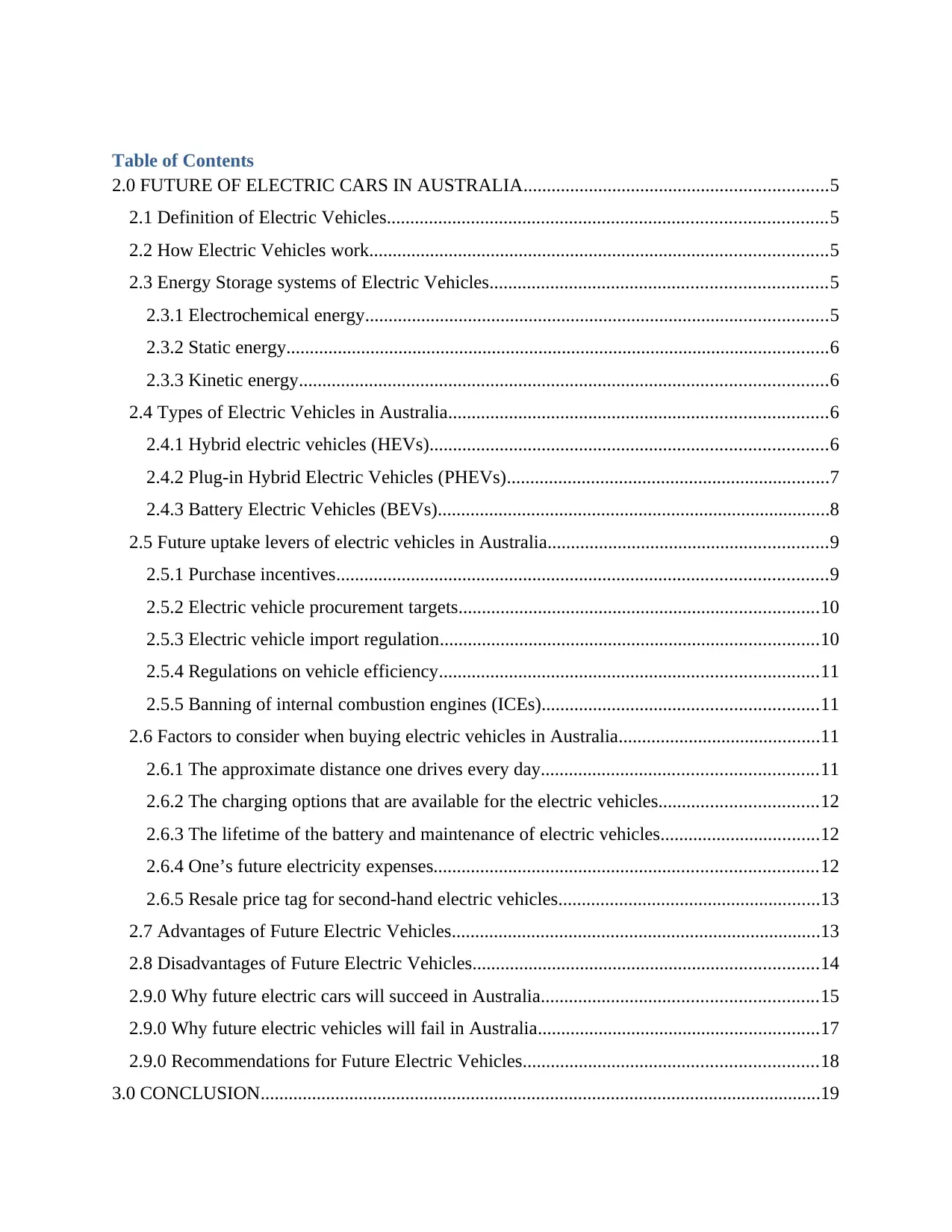
Table of Contents
2.0 FUTURE OF ELECTRIC CARS IN AUSTRALIA.................................................................5
2.1 Definition of Electric Vehicles..............................................................................................5
2.2 How Electric Vehicles work..................................................................................................5
2.3 Energy Storage systems of Electric Vehicles........................................................................5
2.3.1 Electrochemical energy...................................................................................................5
2.3.2 Static energy....................................................................................................................6
2.3.3 Kinetic energy.................................................................................................................6
2.4 Types of Electric Vehicles in Australia.................................................................................6
2.4.1 Hybrid electric vehicles (HEVs).....................................................................................6
2.4.2 Plug-in Hybrid Electric Vehicles (PHEVs).....................................................................7
2.4.3 Battery Electric Vehicles (BEVs)....................................................................................8
2.5 Future uptake levers of electric vehicles in Australia............................................................9
2.5.1 Purchase incentives.........................................................................................................9
2.5.2 Electric vehicle procurement targets.............................................................................10
2.5.3 Electric vehicle import regulation.................................................................................10
2.5.4 Regulations on vehicle efficiency.................................................................................11
2.5.5 Banning of internal combustion engines (ICEs)...........................................................11
2.6 Factors to consider when buying electric vehicles in Australia...........................................11
2.6.1 The approximate distance one drives every day...........................................................11
2.6.2 The charging options that are available for the electric vehicles..................................12
2.6.3 The lifetime of the battery and maintenance of electric vehicles..................................12
2.6.4 One’s future electricity expenses..................................................................................12
2.6.5 Resale price tag for second-hand electric vehicles........................................................13
2.7 Advantages of Future Electric Vehicles...............................................................................13
2.8 Disadvantages of Future Electric Vehicles..........................................................................14
2.9.0 Why future electric cars will succeed in Australia...........................................................15
2.9.0 Why future electric vehicles will fail in Australia............................................................17
2.9.0 Recommendations for Future Electric Vehicles...............................................................18
3.0 CONCLUSION........................................................................................................................19
2.0 FUTURE OF ELECTRIC CARS IN AUSTRALIA.................................................................5
2.1 Definition of Electric Vehicles..............................................................................................5
2.2 How Electric Vehicles work..................................................................................................5
2.3 Energy Storage systems of Electric Vehicles........................................................................5
2.3.1 Electrochemical energy...................................................................................................5
2.3.2 Static energy....................................................................................................................6
2.3.3 Kinetic energy.................................................................................................................6
2.4 Types of Electric Vehicles in Australia.................................................................................6
2.4.1 Hybrid electric vehicles (HEVs).....................................................................................6
2.4.2 Plug-in Hybrid Electric Vehicles (PHEVs).....................................................................7
2.4.3 Battery Electric Vehicles (BEVs)....................................................................................8
2.5 Future uptake levers of electric vehicles in Australia............................................................9
2.5.1 Purchase incentives.........................................................................................................9
2.5.2 Electric vehicle procurement targets.............................................................................10
2.5.3 Electric vehicle import regulation.................................................................................10
2.5.4 Regulations on vehicle efficiency.................................................................................11
2.5.5 Banning of internal combustion engines (ICEs)...........................................................11
2.6 Factors to consider when buying electric vehicles in Australia...........................................11
2.6.1 The approximate distance one drives every day...........................................................11
2.6.2 The charging options that are available for the electric vehicles..................................12
2.6.3 The lifetime of the battery and maintenance of electric vehicles..................................12
2.6.4 One’s future electricity expenses..................................................................................12
2.6.5 Resale price tag for second-hand electric vehicles........................................................13
2.7 Advantages of Future Electric Vehicles...............................................................................13
2.8 Disadvantages of Future Electric Vehicles..........................................................................14
2.9.0 Why future electric cars will succeed in Australia...........................................................15
2.9.0 Why future electric vehicles will fail in Australia............................................................17
2.9.0 Recommendations for Future Electric Vehicles...............................................................18
3.0 CONCLUSION........................................................................................................................19
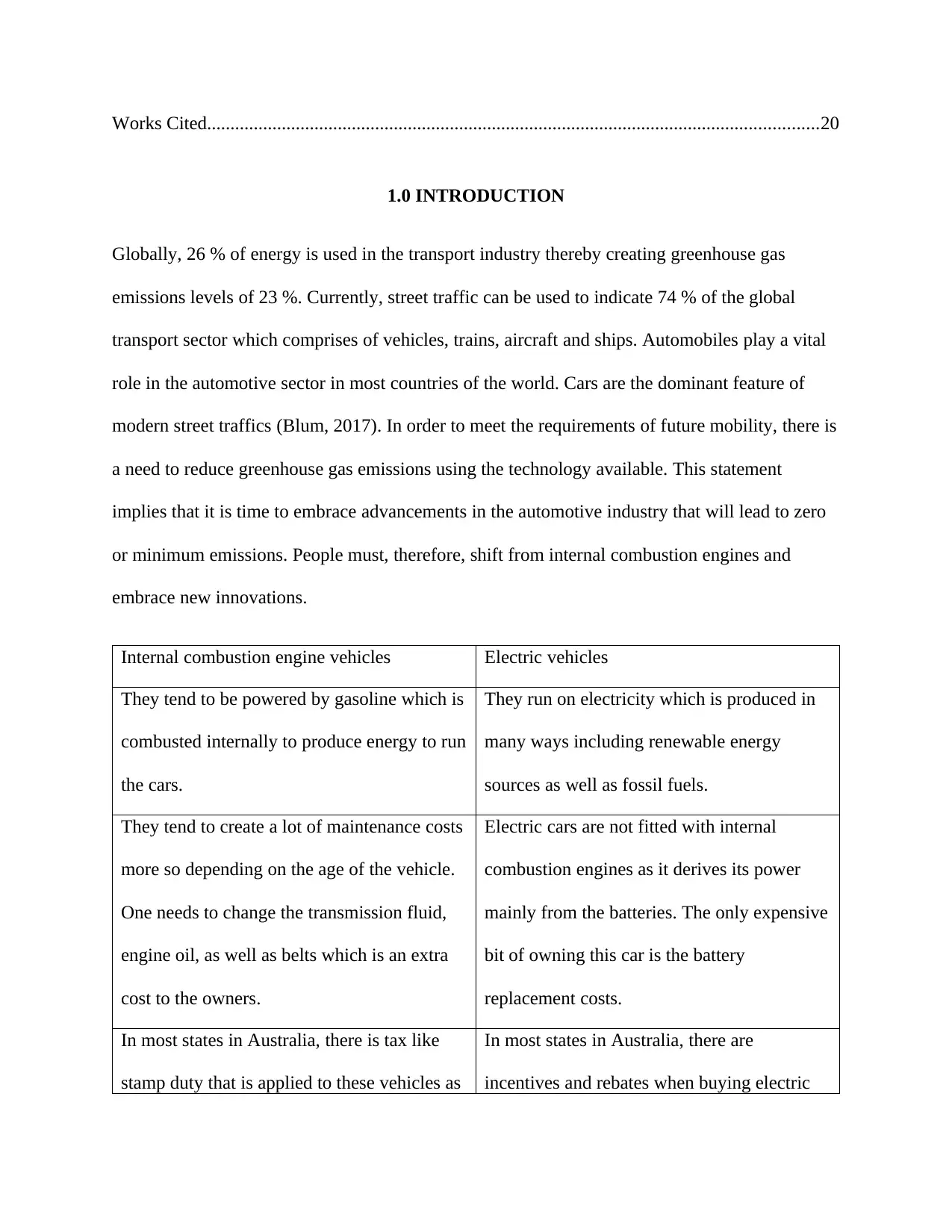
Works Cited...................................................................................................................................20
1.0 INTRODUCTION
Globally, 26 % of energy is used in the transport industry thereby creating greenhouse gas
emissions levels of 23 %. Currently, street traffic can be used to indicate 74 % of the global
transport sector which comprises of vehicles, trains, aircraft and ships. Automobiles play a vital
role in the automotive sector in most countries of the world. Cars are the dominant feature of
modern street traffics (Blum, 2017). In order to meet the requirements of future mobility, there is
a need to reduce greenhouse gas emissions using the technology available. This statement
implies that it is time to embrace advancements in the automotive industry that will lead to zero
or minimum emissions. People must, therefore, shift from internal combustion engines and
embrace new innovations.
Internal combustion engine vehicles Electric vehicles
They tend to be powered by gasoline which is
combusted internally to produce energy to run
the cars.
They run on electricity which is produced in
many ways including renewable energy
sources as well as fossil fuels.
They tend to create a lot of maintenance costs
more so depending on the age of the vehicle.
One needs to change the transmission fluid,
engine oil, as well as belts which is an extra
cost to the owners.
Electric cars are not fitted with internal
combustion engines as it derives its power
mainly from the batteries. The only expensive
bit of owning this car is the battery
replacement costs.
In most states in Australia, there is tax like
stamp duty that is applied to these vehicles as
In most states in Australia, there are
incentives and rebates when buying electric
1.0 INTRODUCTION
Globally, 26 % of energy is used in the transport industry thereby creating greenhouse gas
emissions levels of 23 %. Currently, street traffic can be used to indicate 74 % of the global
transport sector which comprises of vehicles, trains, aircraft and ships. Automobiles play a vital
role in the automotive sector in most countries of the world. Cars are the dominant feature of
modern street traffics (Blum, 2017). In order to meet the requirements of future mobility, there is
a need to reduce greenhouse gas emissions using the technology available. This statement
implies that it is time to embrace advancements in the automotive industry that will lead to zero
or minimum emissions. People must, therefore, shift from internal combustion engines and
embrace new innovations.
Internal combustion engine vehicles Electric vehicles
They tend to be powered by gasoline which is
combusted internally to produce energy to run
the cars.
They run on electricity which is produced in
many ways including renewable energy
sources as well as fossil fuels.
They tend to create a lot of maintenance costs
more so depending on the age of the vehicle.
One needs to change the transmission fluid,
engine oil, as well as belts which is an extra
cost to the owners.
Electric cars are not fitted with internal
combustion engines as it derives its power
mainly from the batteries. The only expensive
bit of owning this car is the battery
replacement costs.
In most states in Australia, there is tax like
stamp duty that is applied to these vehicles as
In most states in Australia, there are
incentives and rebates when buying electric
⊘ This is a preview!⊘
Do you want full access?
Subscribe today to unlock all pages.

Trusted by 1+ million students worldwide
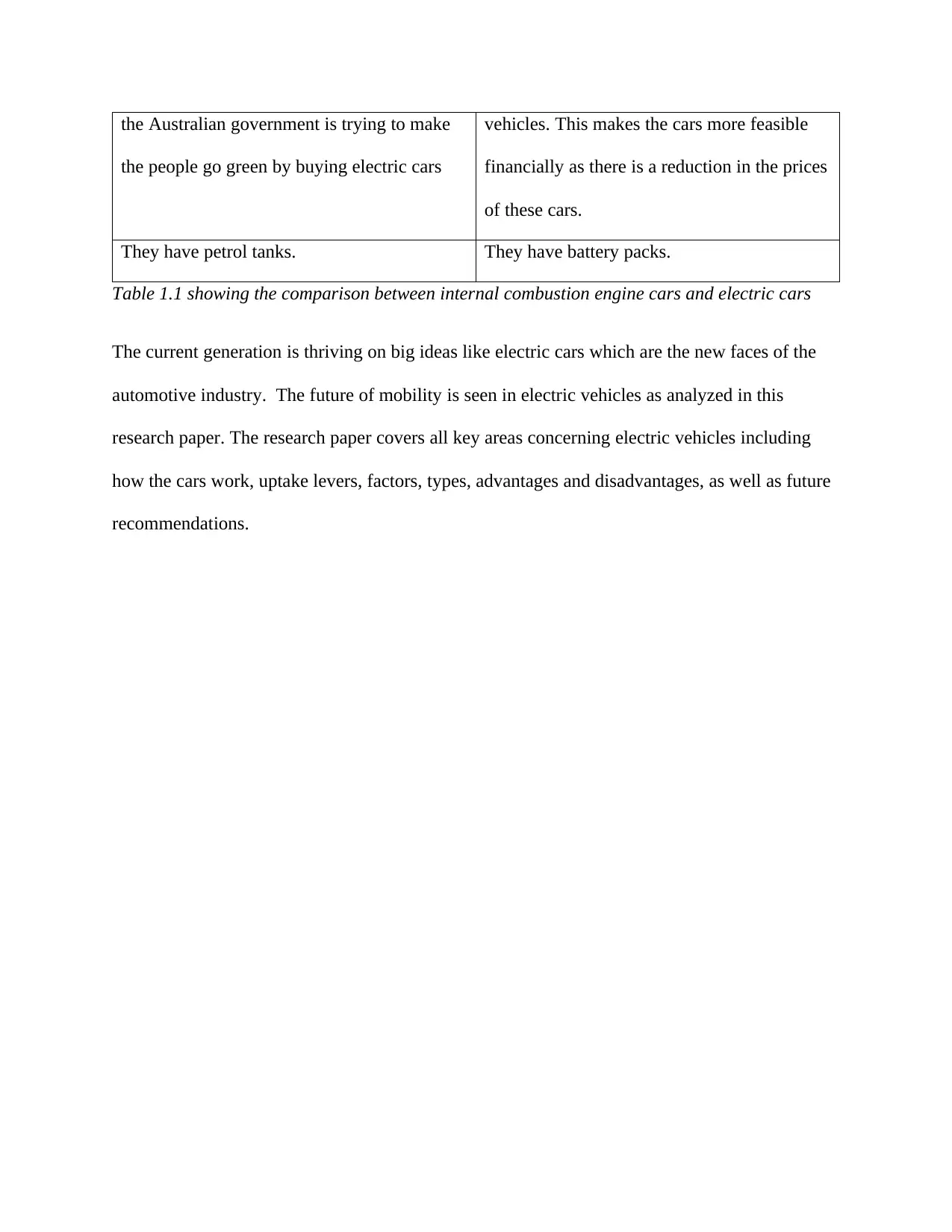
the Australian government is trying to make
the people go green by buying electric cars
vehicles. This makes the cars more feasible
financially as there is a reduction in the prices
of these cars.
They have petrol tanks. They have battery packs.
Table 1.1 showing the comparison between internal combustion engine cars and electric cars
The current generation is thriving on big ideas like electric cars which are the new faces of the
automotive industry. The future of mobility is seen in electric vehicles as analyzed in this
research paper. The research paper covers all key areas concerning electric vehicles including
how the cars work, uptake levers, factors, types, advantages and disadvantages, as well as future
recommendations.
the people go green by buying electric cars
vehicles. This makes the cars more feasible
financially as there is a reduction in the prices
of these cars.
They have petrol tanks. They have battery packs.
Table 1.1 showing the comparison between internal combustion engine cars and electric cars
The current generation is thriving on big ideas like electric cars which are the new faces of the
automotive industry. The future of mobility is seen in electric vehicles as analyzed in this
research paper. The research paper covers all key areas concerning electric vehicles including
how the cars work, uptake levers, factors, types, advantages and disadvantages, as well as future
recommendations.
Paraphrase This Document
Need a fresh take? Get an instant paraphrase of this document with our AI Paraphraser
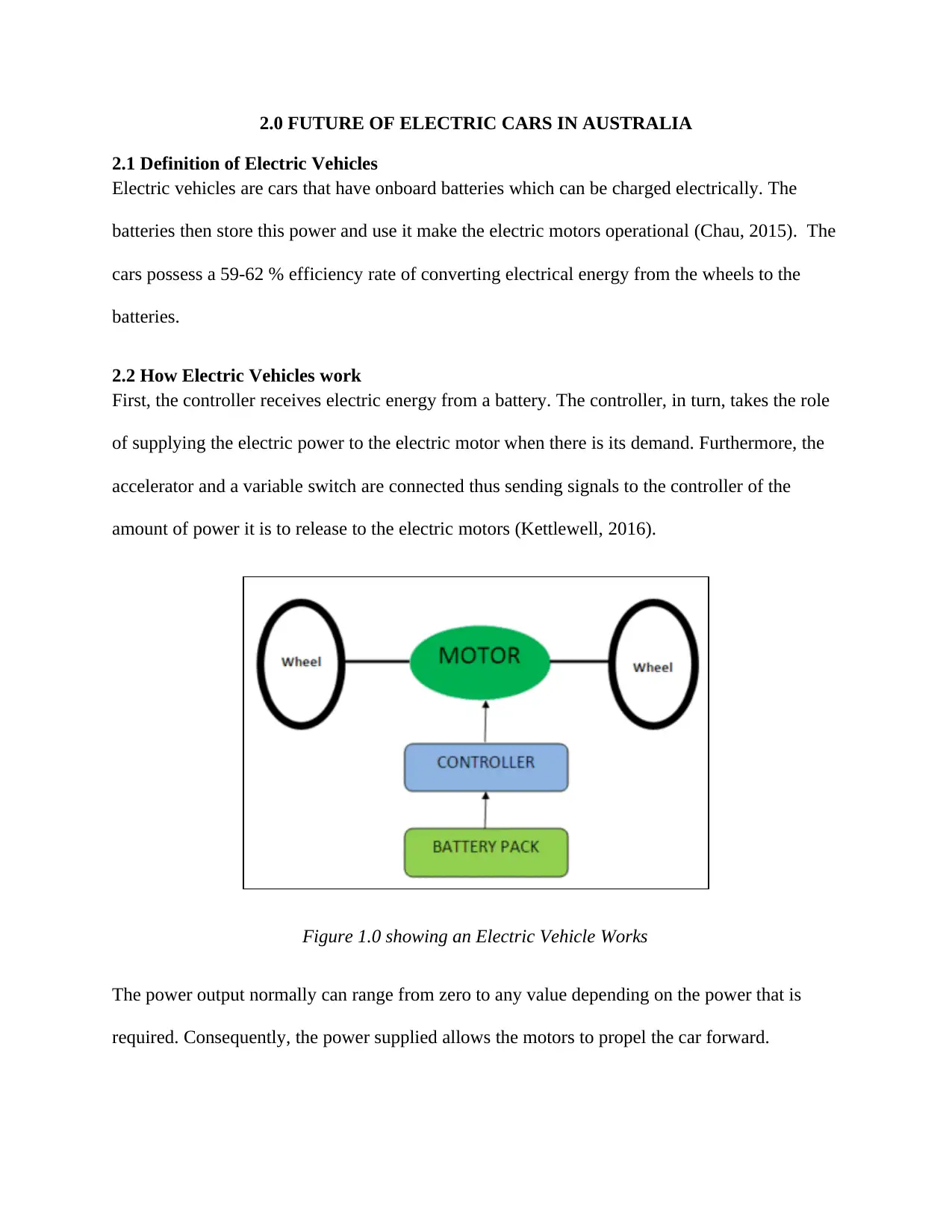
2.0 FUTURE OF ELECTRIC CARS IN AUSTRALIA
2.1 Definition of Electric Vehicles
Electric vehicles are cars that have onboard batteries which can be charged electrically. The
batteries then store this power and use it make the electric motors operational (Chau, 2015). The
cars possess a 59-62 % efficiency rate of converting electrical energy from the wheels to the
batteries.
2.2 How Electric Vehicles work
First, the controller receives electric energy from a battery. The controller, in turn, takes the role
of supplying the electric power to the electric motor when there is its demand. Furthermore, the
accelerator and a variable switch are connected thus sending signals to the controller of the
amount of power it is to release to the electric motors (Kettlewell, 2016).
Figure 1.0 showing an Electric Vehicle Works
The power output normally can range from zero to any value depending on the power that is
required. Consequently, the power supplied allows the motors to propel the car forward.
2.1 Definition of Electric Vehicles
Electric vehicles are cars that have onboard batteries which can be charged electrically. The
batteries then store this power and use it make the electric motors operational (Chau, 2015). The
cars possess a 59-62 % efficiency rate of converting electrical energy from the wheels to the
batteries.
2.2 How Electric Vehicles work
First, the controller receives electric energy from a battery. The controller, in turn, takes the role
of supplying the electric power to the electric motor when there is its demand. Furthermore, the
accelerator and a variable switch are connected thus sending signals to the controller of the
amount of power it is to release to the electric motors (Kettlewell, 2016).
Figure 1.0 showing an Electric Vehicle Works
The power output normally can range from zero to any value depending on the power that is
required. Consequently, the power supplied allows the motors to propel the car forward.
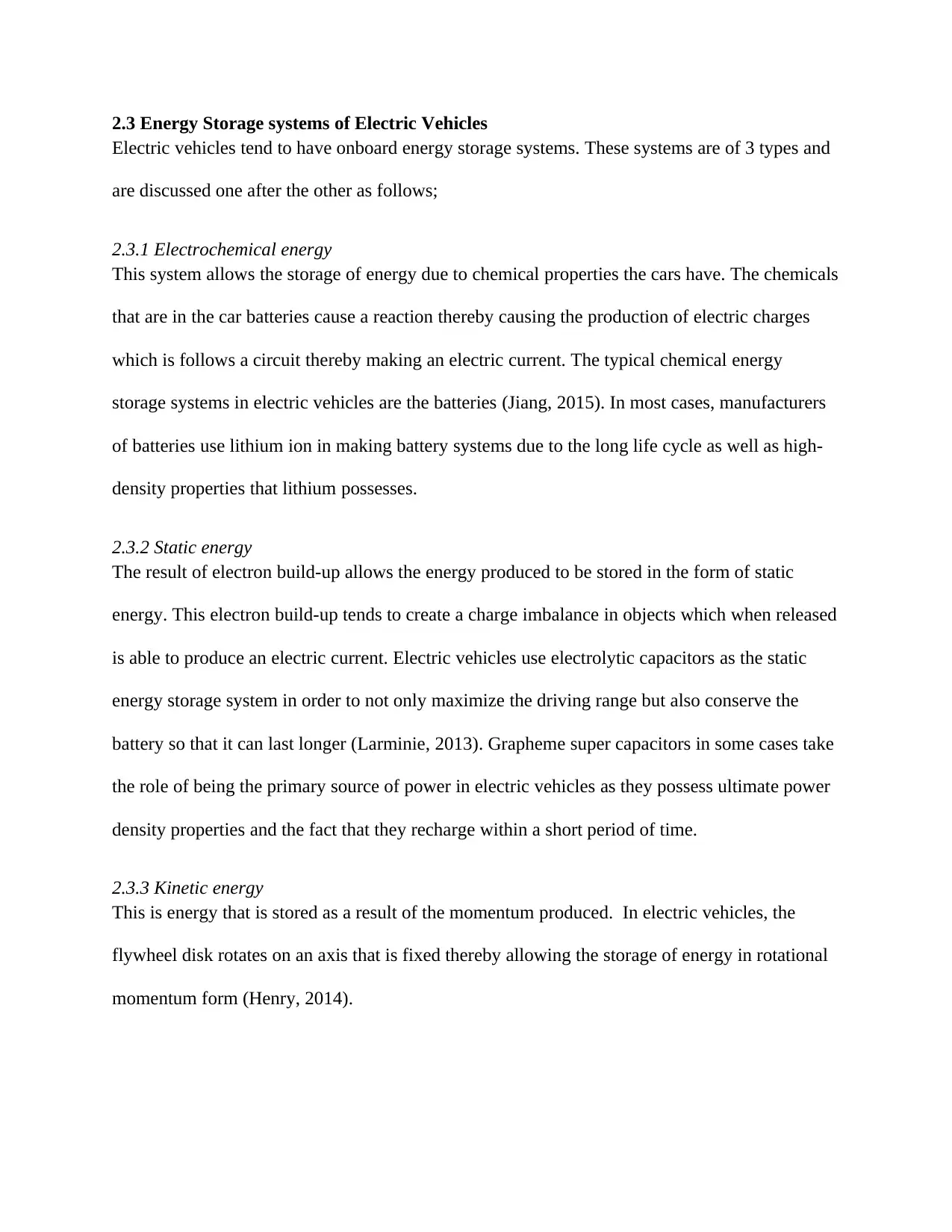
2.3 Energy Storage systems of Electric Vehicles
Electric vehicles tend to have onboard energy storage systems. These systems are of 3 types and
are discussed one after the other as follows;
2.3.1 Electrochemical energy
This system allows the storage of energy due to chemical properties the cars have. The chemicals
that are in the car batteries cause a reaction thereby causing the production of electric charges
which is follows a circuit thereby making an electric current. The typical chemical energy
storage systems in electric vehicles are the batteries (Jiang, 2015). In most cases, manufacturers
of batteries use lithium ion in making battery systems due to the long life cycle as well as high-
density properties that lithium possesses.
2.3.2 Static energy
The result of electron build-up allows the energy produced to be stored in the form of static
energy. This electron build-up tends to create a charge imbalance in objects which when released
is able to produce an electric current. Electric vehicles use electrolytic capacitors as the static
energy storage system in order to not only maximize the driving range but also conserve the
battery so that it can last longer (Larminie, 2013). Grapheme super capacitors in some cases take
the role of being the primary source of power in electric vehicles as they possess ultimate power
density properties and the fact that they recharge within a short period of time.
2.3.3 Kinetic energy
This is energy that is stored as a result of the momentum produced. In electric vehicles, the
flywheel disk rotates on an axis that is fixed thereby allowing the storage of energy in rotational
momentum form (Henry, 2014).
Electric vehicles tend to have onboard energy storage systems. These systems are of 3 types and
are discussed one after the other as follows;
2.3.1 Electrochemical energy
This system allows the storage of energy due to chemical properties the cars have. The chemicals
that are in the car batteries cause a reaction thereby causing the production of electric charges
which is follows a circuit thereby making an electric current. The typical chemical energy
storage systems in electric vehicles are the batteries (Jiang, 2015). In most cases, manufacturers
of batteries use lithium ion in making battery systems due to the long life cycle as well as high-
density properties that lithium possesses.
2.3.2 Static energy
The result of electron build-up allows the energy produced to be stored in the form of static
energy. This electron build-up tends to create a charge imbalance in objects which when released
is able to produce an electric current. Electric vehicles use electrolytic capacitors as the static
energy storage system in order to not only maximize the driving range but also conserve the
battery so that it can last longer (Larminie, 2013). Grapheme super capacitors in some cases take
the role of being the primary source of power in electric vehicles as they possess ultimate power
density properties and the fact that they recharge within a short period of time.
2.3.3 Kinetic energy
This is energy that is stored as a result of the momentum produced. In electric vehicles, the
flywheel disk rotates on an axis that is fixed thereby allowing the storage of energy in rotational
momentum form (Henry, 2014).
⊘ This is a preview!⊘
Do you want full access?
Subscribe today to unlock all pages.

Trusted by 1+ million students worldwide
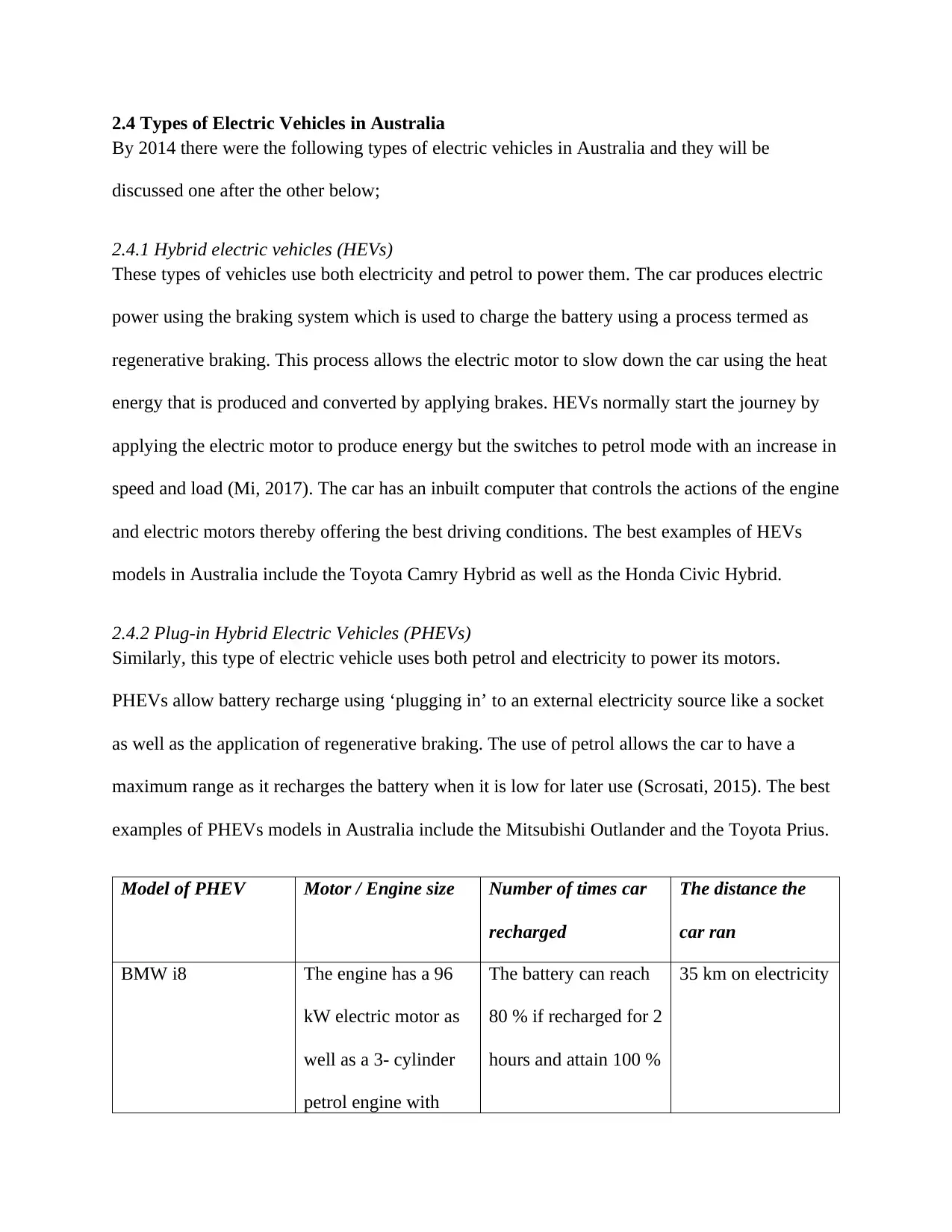
2.4 Types of Electric Vehicles in Australia
By 2014 there were the following types of electric vehicles in Australia and they will be
discussed one after the other below;
2.4.1 Hybrid electric vehicles (HEVs)
These types of vehicles use both electricity and petrol to power them. The car produces electric
power using the braking system which is used to charge the battery using a process termed as
regenerative braking. This process allows the electric motor to slow down the car using the heat
energy that is produced and converted by applying brakes. HEVs normally start the journey by
applying the electric motor to produce energy but the switches to petrol mode with an increase in
speed and load (Mi, 2017). The car has an inbuilt computer that controls the actions of the engine
and electric motors thereby offering the best driving conditions. The best examples of HEVs
models in Australia include the Toyota Camry Hybrid as well as the Honda Civic Hybrid.
2.4.2 Plug-in Hybrid Electric Vehicles (PHEVs)
Similarly, this type of electric vehicle uses both petrol and electricity to power its motors.
PHEVs allow battery recharge using ‘plugging in’ to an external electricity source like a socket
as well as the application of regenerative braking. The use of petrol allows the car to have a
maximum range as it recharges the battery when it is low for later use (Scrosati, 2015). The best
examples of PHEVs models in Australia include the Mitsubishi Outlander and the Toyota Prius.
Model of PHEV Motor / Engine size Number of times car
recharged
The distance the
car ran
BMW i8 The engine has a 96
kW electric motor as
well as a 3- cylinder
petrol engine with
The battery can reach
80 % if recharged for 2
hours and attain 100 %
35 km on electricity
By 2014 there were the following types of electric vehicles in Australia and they will be
discussed one after the other below;
2.4.1 Hybrid electric vehicles (HEVs)
These types of vehicles use both electricity and petrol to power them. The car produces electric
power using the braking system which is used to charge the battery using a process termed as
regenerative braking. This process allows the electric motor to slow down the car using the heat
energy that is produced and converted by applying brakes. HEVs normally start the journey by
applying the electric motor to produce energy but the switches to petrol mode with an increase in
speed and load (Mi, 2017). The car has an inbuilt computer that controls the actions of the engine
and electric motors thereby offering the best driving conditions. The best examples of HEVs
models in Australia include the Toyota Camry Hybrid as well as the Honda Civic Hybrid.
2.4.2 Plug-in Hybrid Electric Vehicles (PHEVs)
Similarly, this type of electric vehicle uses both petrol and electricity to power its motors.
PHEVs allow battery recharge using ‘plugging in’ to an external electricity source like a socket
as well as the application of regenerative braking. The use of petrol allows the car to have a
maximum range as it recharges the battery when it is low for later use (Scrosati, 2015). The best
examples of PHEVs models in Australia include the Mitsubishi Outlander and the Toyota Prius.
Model of PHEV Motor / Engine size Number of times car
recharged
The distance the
car ran
BMW i8 The engine has a 96
kW electric motor as
well as a 3- cylinder
petrol engine with
The battery can reach
80 % if recharged for 2
hours and attain 100 %
35 km on electricity
Paraphrase This Document
Need a fresh take? Get an instant paraphrase of this document with our AI Paraphraser
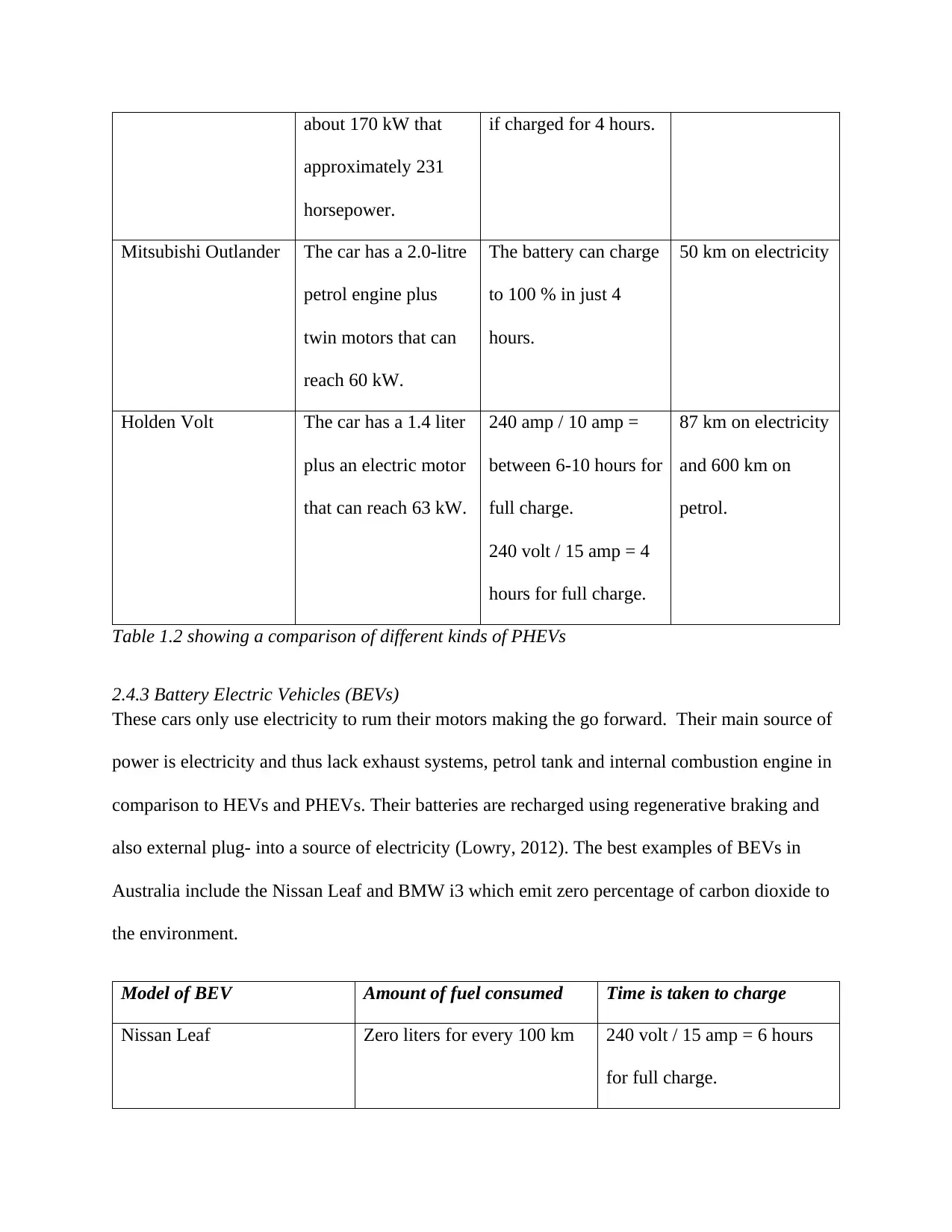
about 170 kW that
approximately 231
horsepower.
if charged for 4 hours.
Mitsubishi Outlander The car has a 2.0-litre
petrol engine plus
twin motors that can
reach 60 kW.
The battery can charge
to 100 % in just 4
hours.
50 km on electricity
Holden Volt The car has a 1.4 liter
plus an electric motor
that can reach 63 kW.
240 amp / 10 amp =
between 6-10 hours for
full charge.
240 volt / 15 amp = 4
hours for full charge.
87 km on electricity
and 600 km on
petrol.
Table 1.2 showing a comparison of different kinds of PHEVs
2.4.3 Battery Electric Vehicles (BEVs)
These cars only use electricity to rum their motors making the go forward. Their main source of
power is electricity and thus lack exhaust systems, petrol tank and internal combustion engine in
comparison to HEVs and PHEVs. Their batteries are recharged using regenerative braking and
also external plug- into a source of electricity (Lowry, 2012). The best examples of BEVs in
Australia include the Nissan Leaf and BMW i3 which emit zero percentage of carbon dioxide to
the environment.
Model of BEV Amount of fuel consumed Time is taken to charge
Nissan Leaf Zero liters for every 100 km 240 volt / 15 amp = 6 hours
for full charge.
approximately 231
horsepower.
if charged for 4 hours.
Mitsubishi Outlander The car has a 2.0-litre
petrol engine plus
twin motors that can
reach 60 kW.
The battery can charge
to 100 % in just 4
hours.
50 km on electricity
Holden Volt The car has a 1.4 liter
plus an electric motor
that can reach 63 kW.
240 amp / 10 amp =
between 6-10 hours for
full charge.
240 volt / 15 amp = 4
hours for full charge.
87 km on electricity
and 600 km on
petrol.
Table 1.2 showing a comparison of different kinds of PHEVs
2.4.3 Battery Electric Vehicles (BEVs)
These cars only use electricity to rum their motors making the go forward. Their main source of
power is electricity and thus lack exhaust systems, petrol tank and internal combustion engine in
comparison to HEVs and PHEVs. Their batteries are recharged using regenerative braking and
also external plug- into a source of electricity (Lowry, 2012). The best examples of BEVs in
Australia include the Nissan Leaf and BMW i3 which emit zero percentage of carbon dioxide to
the environment.
Model of BEV Amount of fuel consumed Time is taken to charge
Nissan Leaf Zero liters for every 100 km 240 volt / 15 amp = 6 hours
for full charge.
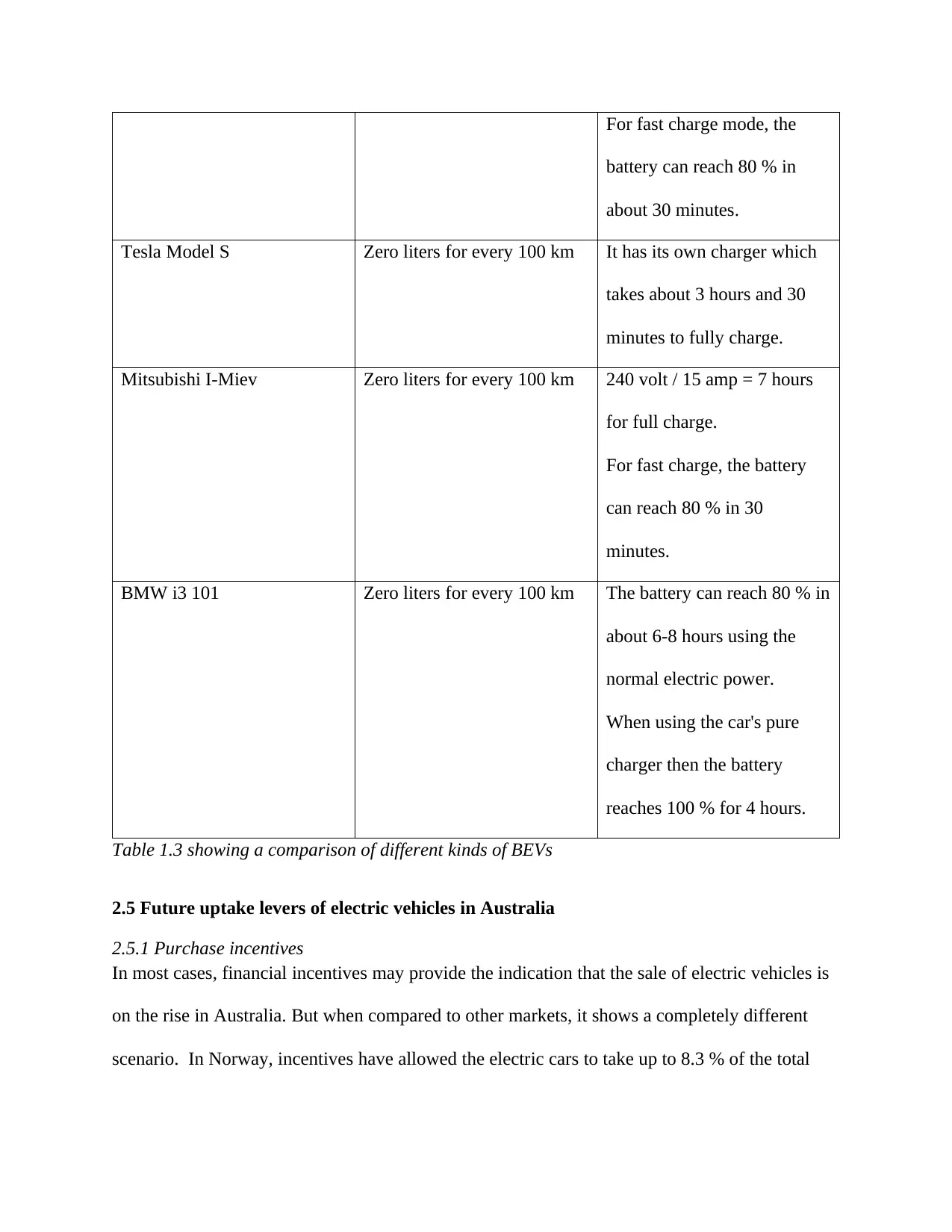
For fast charge mode, the
battery can reach 80 % in
about 30 minutes.
Tesla Model S Zero liters for every 100 km It has its own charger which
takes about 3 hours and 30
minutes to fully charge.
Mitsubishi I-Miev Zero liters for every 100 km 240 volt / 15 amp = 7 hours
for full charge.
For fast charge, the battery
can reach 80 % in 30
minutes.
BMW i3 101 Zero liters for every 100 km The battery can reach 80 % in
about 6-8 hours using the
normal electric power.
When using the car's pure
charger then the battery
reaches 100 % for 4 hours.
Table 1.3 showing a comparison of different kinds of BEVs
2.5 Future uptake levers of electric vehicles in Australia
2.5.1 Purchase incentives
In most cases, financial incentives may provide the indication that the sale of electric vehicles is
on the rise in Australia. But when compared to other markets, it shows a completely different
scenario. In Norway, incentives have allowed the electric cars to take up to 8.3 % of the total
battery can reach 80 % in
about 30 minutes.
Tesla Model S Zero liters for every 100 km It has its own charger which
takes about 3 hours and 30
minutes to fully charge.
Mitsubishi I-Miev Zero liters for every 100 km 240 volt / 15 amp = 7 hours
for full charge.
For fast charge, the battery
can reach 80 % in 30
minutes.
BMW i3 101 Zero liters for every 100 km The battery can reach 80 % in
about 6-8 hours using the
normal electric power.
When using the car's pure
charger then the battery
reaches 100 % for 4 hours.
Table 1.3 showing a comparison of different kinds of BEVs
2.5 Future uptake levers of electric vehicles in Australia
2.5.1 Purchase incentives
In most cases, financial incentives may provide the indication that the sale of electric vehicles is
on the rise in Australia. But when compared to other markets, it shows a completely different
scenario. In Norway, incentives have allowed the electric cars to take up to 8.3 % of the total
⊘ This is a preview!⊘
Do you want full access?
Subscribe today to unlock all pages.

Trusted by 1+ million students worldwide
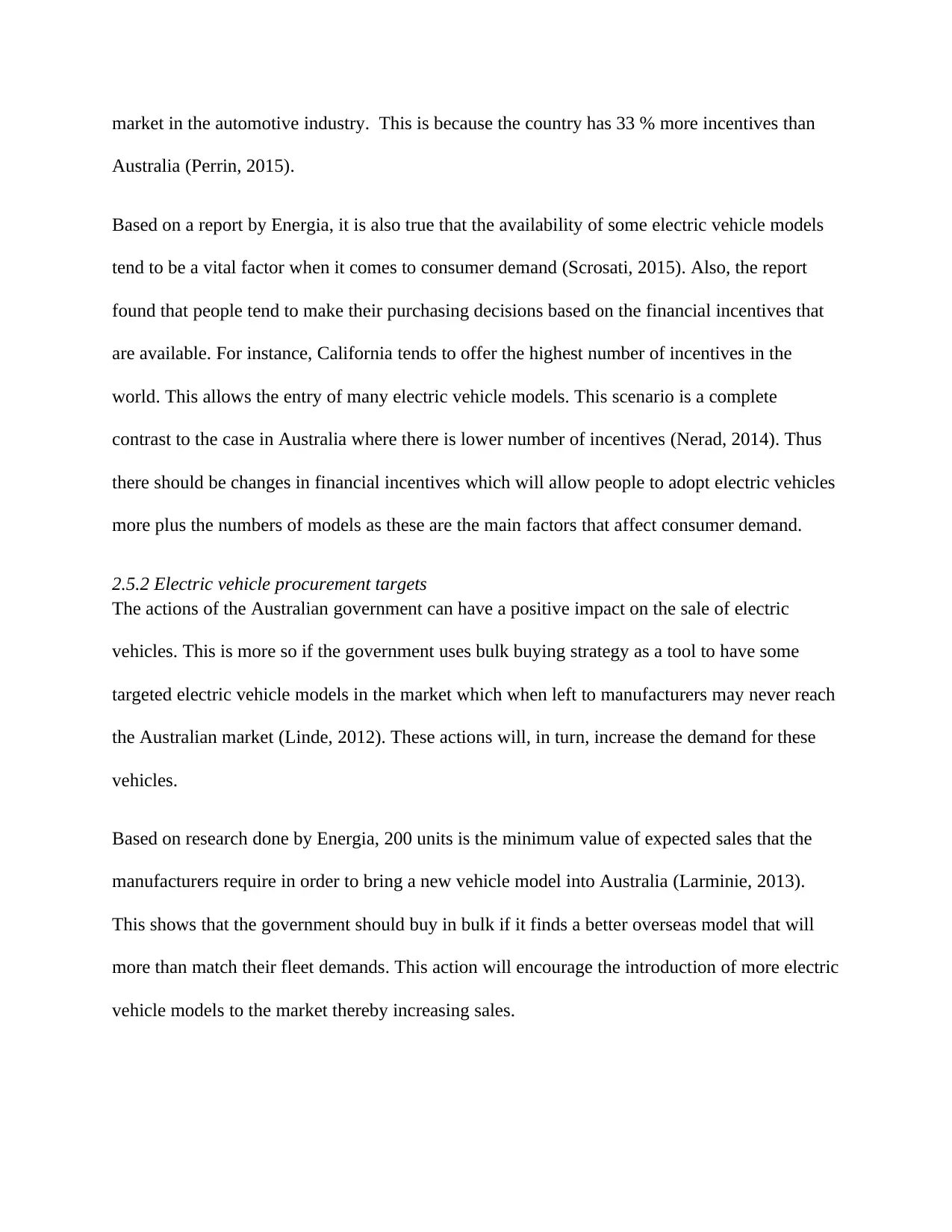
market in the automotive industry. This is because the country has 33 % more incentives than
Australia (Perrin, 2015).
Based on a report by Energia, it is also true that the availability of some electric vehicle models
tend to be a vital factor when it comes to consumer demand (Scrosati, 2015). Also, the report
found that people tend to make their purchasing decisions based on the financial incentives that
are available. For instance, California tends to offer the highest number of incentives in the
world. This allows the entry of many electric vehicle models. This scenario is a complete
contrast to the case in Australia where there is lower number of incentives (Nerad, 2014). Thus
there should be changes in financial incentives which will allow people to adopt electric vehicles
more plus the numbers of models as these are the main factors that affect consumer demand.
2.5.2 Electric vehicle procurement targets
The actions of the Australian government can have a positive impact on the sale of electric
vehicles. This is more so if the government uses bulk buying strategy as a tool to have some
targeted electric vehicle models in the market which when left to manufacturers may never reach
the Australian market (Linde, 2012). These actions will, in turn, increase the demand for these
vehicles.
Based on research done by Energia, 200 units is the minimum value of expected sales that the
manufacturers require in order to bring a new vehicle model into Australia (Larminie, 2013).
This shows that the government should buy in bulk if it finds a better overseas model that will
more than match their fleet demands. This action will encourage the introduction of more electric
vehicle models to the market thereby increasing sales.
Australia (Perrin, 2015).
Based on a report by Energia, it is also true that the availability of some electric vehicle models
tend to be a vital factor when it comes to consumer demand (Scrosati, 2015). Also, the report
found that people tend to make their purchasing decisions based on the financial incentives that
are available. For instance, California tends to offer the highest number of incentives in the
world. This allows the entry of many electric vehicle models. This scenario is a complete
contrast to the case in Australia where there is lower number of incentives (Nerad, 2014). Thus
there should be changes in financial incentives which will allow people to adopt electric vehicles
more plus the numbers of models as these are the main factors that affect consumer demand.
2.5.2 Electric vehicle procurement targets
The actions of the Australian government can have a positive impact on the sale of electric
vehicles. This is more so if the government uses bulk buying strategy as a tool to have some
targeted electric vehicle models in the market which when left to manufacturers may never reach
the Australian market (Linde, 2012). These actions will, in turn, increase the demand for these
vehicles.
Based on research done by Energia, 200 units is the minimum value of expected sales that the
manufacturers require in order to bring a new vehicle model into Australia (Larminie, 2013).
This shows that the government should buy in bulk if it finds a better overseas model that will
more than match their fleet demands. This action will encourage the introduction of more electric
vehicle models to the market thereby increasing sales.
Paraphrase This Document
Need a fresh take? Get an instant paraphrase of this document with our AI Paraphraser
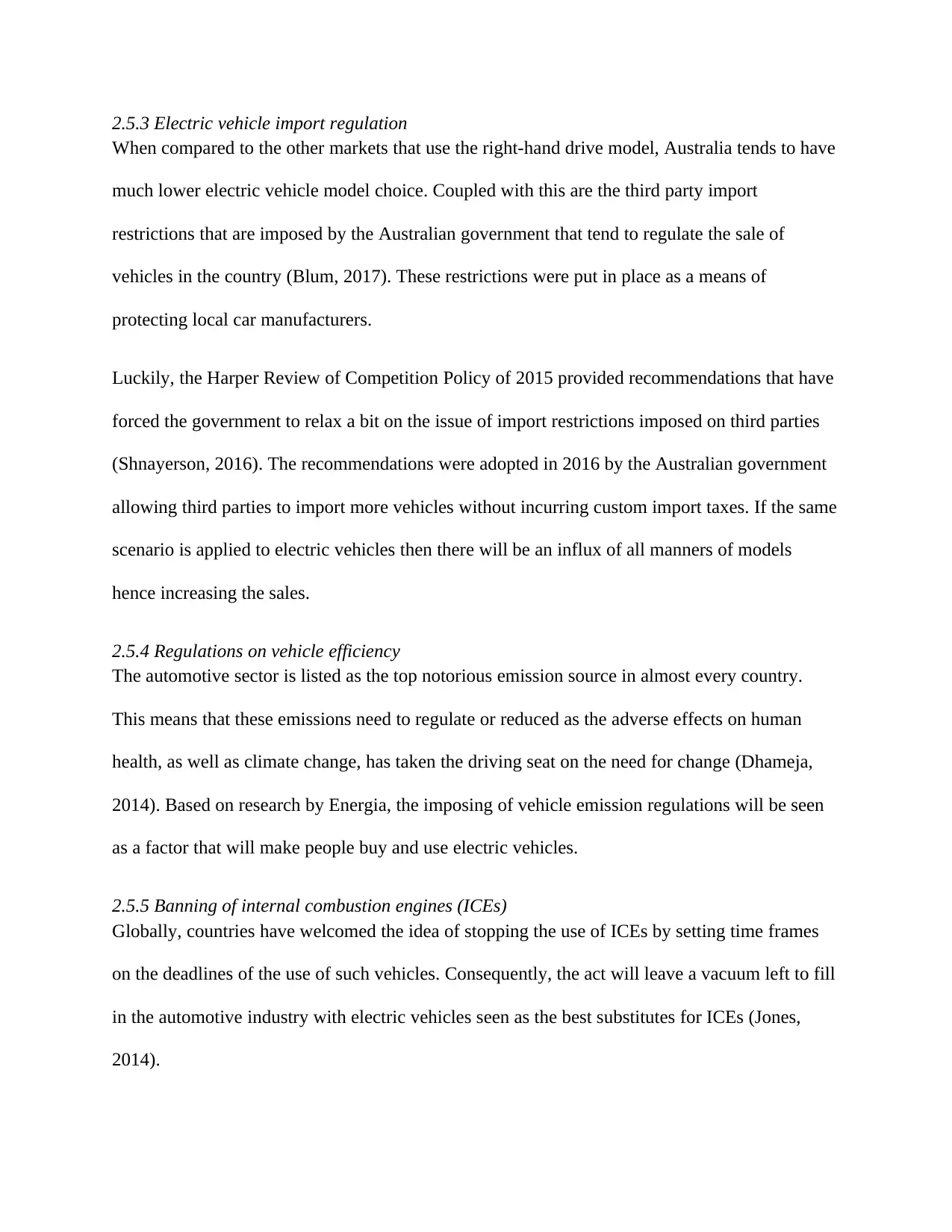
2.5.3 Electric vehicle import regulation
When compared to the other markets that use the right-hand drive model, Australia tends to have
much lower electric vehicle model choice. Coupled with this are the third party import
restrictions that are imposed by the Australian government that tend to regulate the sale of
vehicles in the country (Blum, 2017). These restrictions were put in place as a means of
protecting local car manufacturers.
Luckily, the Harper Review of Competition Policy of 2015 provided recommendations that have
forced the government to relax a bit on the issue of import restrictions imposed on third parties
(Shnayerson, 2016). The recommendations were adopted in 2016 by the Australian government
allowing third parties to import more vehicles without incurring custom import taxes. If the same
scenario is applied to electric vehicles then there will be an influx of all manners of models
hence increasing the sales.
2.5.4 Regulations on vehicle efficiency
The automotive sector is listed as the top notorious emission source in almost every country.
This means that these emissions need to regulate or reduced as the adverse effects on human
health, as well as climate change, has taken the driving seat on the need for change (Dhameja,
2014). Based on research by Energia, the imposing of vehicle emission regulations will be seen
as a factor that will make people buy and use electric vehicles.
2.5.5 Banning of internal combustion engines (ICEs)
Globally, countries have welcomed the idea of stopping the use of ICEs by setting time frames
on the deadlines of the use of such vehicles. Consequently, the act will leave a vacuum left to fill
in the automotive industry with electric vehicles seen as the best substitutes for ICEs (Jones,
2014).
When compared to the other markets that use the right-hand drive model, Australia tends to have
much lower electric vehicle model choice. Coupled with this are the third party import
restrictions that are imposed by the Australian government that tend to regulate the sale of
vehicles in the country (Blum, 2017). These restrictions were put in place as a means of
protecting local car manufacturers.
Luckily, the Harper Review of Competition Policy of 2015 provided recommendations that have
forced the government to relax a bit on the issue of import restrictions imposed on third parties
(Shnayerson, 2016). The recommendations were adopted in 2016 by the Australian government
allowing third parties to import more vehicles without incurring custom import taxes. If the same
scenario is applied to electric vehicles then there will be an influx of all manners of models
hence increasing the sales.
2.5.4 Regulations on vehicle efficiency
The automotive sector is listed as the top notorious emission source in almost every country.
This means that these emissions need to regulate or reduced as the adverse effects on human
health, as well as climate change, has taken the driving seat on the need for change (Dhameja,
2014). Based on research by Energia, the imposing of vehicle emission regulations will be seen
as a factor that will make people buy and use electric vehicles.
2.5.5 Banning of internal combustion engines (ICEs)
Globally, countries have welcomed the idea of stopping the use of ICEs by setting time frames
on the deadlines of the use of such vehicles. Consequently, the act will leave a vacuum left to fill
in the automotive industry with electric vehicles seen as the best substitutes for ICEs (Jones,
2014).
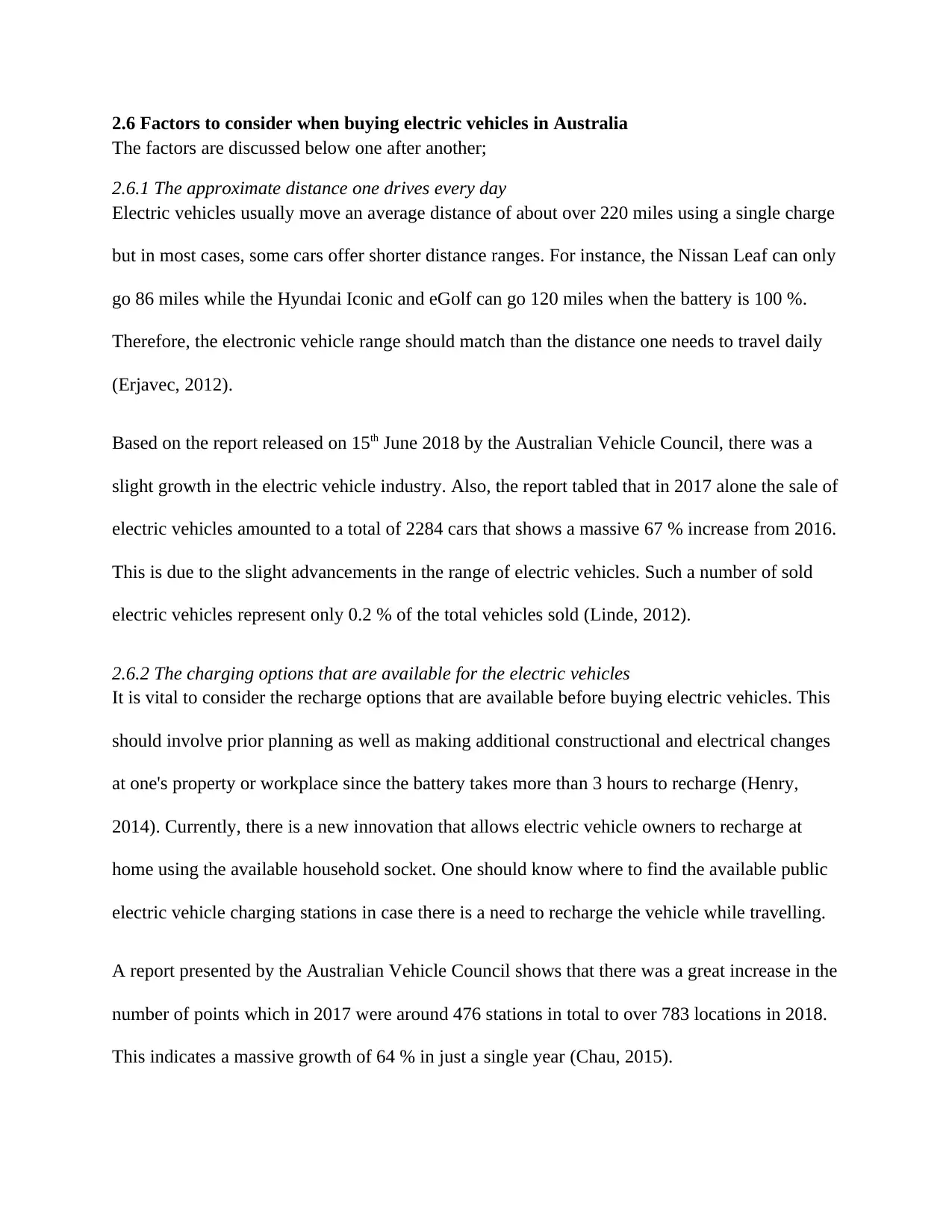
2.6 Factors to consider when buying electric vehicles in Australia
The factors are discussed below one after another;
2.6.1 The approximate distance one drives every day
Electric vehicles usually move an average distance of about over 220 miles using a single charge
but in most cases, some cars offer shorter distance ranges. For instance, the Nissan Leaf can only
go 86 miles while the Hyundai Iconic and eGolf can go 120 miles when the battery is 100 %.
Therefore, the electronic vehicle range should match than the distance one needs to travel daily
(Erjavec, 2012).
Based on the report released on 15th June 2018 by the Australian Vehicle Council, there was a
slight growth in the electric vehicle industry. Also, the report tabled that in 2017 alone the sale of
electric vehicles amounted to a total of 2284 cars that shows a massive 67 % increase from 2016.
This is due to the slight advancements in the range of electric vehicles. Such a number of sold
electric vehicles represent only 0.2 % of the total vehicles sold (Linde, 2012).
2.6.2 The charging options that are available for the electric vehicles
It is vital to consider the recharge options that are available before buying electric vehicles. This
should involve prior planning as well as making additional constructional and electrical changes
at one's property or workplace since the battery takes more than 3 hours to recharge (Henry,
2014). Currently, there is a new innovation that allows electric vehicle owners to recharge at
home using the available household socket. One should know where to find the available public
electric vehicle charging stations in case there is a need to recharge the vehicle while travelling.
A report presented by the Australian Vehicle Council shows that there was a great increase in the
number of points which in 2017 were around 476 stations in total to over 783 locations in 2018.
This indicates a massive growth of 64 % in just a single year (Chau, 2015).
The factors are discussed below one after another;
2.6.1 The approximate distance one drives every day
Electric vehicles usually move an average distance of about over 220 miles using a single charge
but in most cases, some cars offer shorter distance ranges. For instance, the Nissan Leaf can only
go 86 miles while the Hyundai Iconic and eGolf can go 120 miles when the battery is 100 %.
Therefore, the electronic vehicle range should match than the distance one needs to travel daily
(Erjavec, 2012).
Based on the report released on 15th June 2018 by the Australian Vehicle Council, there was a
slight growth in the electric vehicle industry. Also, the report tabled that in 2017 alone the sale of
electric vehicles amounted to a total of 2284 cars that shows a massive 67 % increase from 2016.
This is due to the slight advancements in the range of electric vehicles. Such a number of sold
electric vehicles represent only 0.2 % of the total vehicles sold (Linde, 2012).
2.6.2 The charging options that are available for the electric vehicles
It is vital to consider the recharge options that are available before buying electric vehicles. This
should involve prior planning as well as making additional constructional and electrical changes
at one's property or workplace since the battery takes more than 3 hours to recharge (Henry,
2014). Currently, there is a new innovation that allows electric vehicle owners to recharge at
home using the available household socket. One should know where to find the available public
electric vehicle charging stations in case there is a need to recharge the vehicle while travelling.
A report presented by the Australian Vehicle Council shows that there was a great increase in the
number of points which in 2017 were around 476 stations in total to over 783 locations in 2018.
This indicates a massive growth of 64 % in just a single year (Chau, 2015).
⊘ This is a preview!⊘
Do you want full access?
Subscribe today to unlock all pages.

Trusted by 1+ million students worldwide
1 out of 22
Related Documents
Your All-in-One AI-Powered Toolkit for Academic Success.
+13062052269
info@desklib.com
Available 24*7 on WhatsApp / Email
![[object Object]](/_next/static/media/star-bottom.7253800d.svg)
Unlock your academic potential
Copyright © 2020–2025 A2Z Services. All Rights Reserved. Developed and managed by ZUCOL.
![Hybrid and Electric Vehicles: Battery Power Report - [University Name]](/_next/image/?url=https%3A%2F%2Fdesklib.com%2Fmedia%2Fimages%2Foz%2Fe29569c874f844d2874f09f043debbd5.jpg&w=256&q=75)




